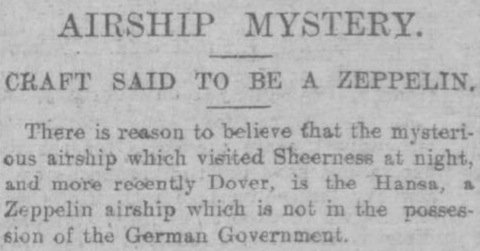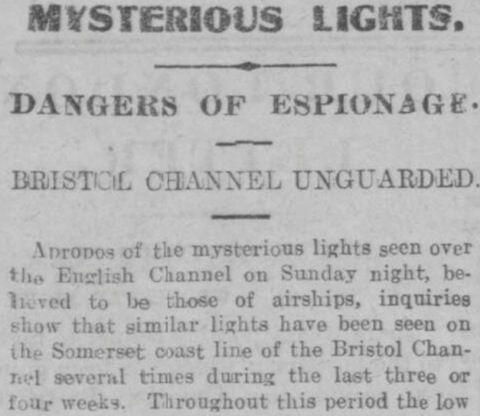
A somewhat atypical phantom airship report appears in today’s newspapers. It’s from the suburbs of one of the great cities, Liverpool. With a population of around three quarters of a million, Liverpool is more than three times the size of the biggest city to have previously reported a mystery aircraft, Cardiff. According to the Standard, (p. 9; above):
Several people report having seen a mysterious aircraft over the north of Liverpool on Saturday evening [25 January 1913] between seven and half-past eight o’clock. They say it was travelling at about 25 miles an hour, and that it carried a very brilliant light. Two members of the Liverpool Aviation School were out on Saturday afternoon, but did not leave the neighbourhood of the shore at Waterloo, and were not in the air at the time stated.
The Times has an equally brief account (p. 13), but it does provide some additional details: the report was made by ‘A resident in the Clubmoor district’, and ‘There were five persons in the house at the time and they watched it for some time’. The Manchester Guardian says much the same (p. 6). Frustratingly, the local Liverpool Echo appears to carry no news article about the Clubmoor aircraft today, even though it does mention it in the leading article (p. 4):
If rumour speaks true, England has already once, if not twice, been invaded by mysterious ships of the air that pass in the night.
Mention is made of a mysterious aircraft which passed over this district after dark on Saturday evening last.
The leading article itself is entitled ‘Air power and sea power’, and criticises the government for lagging in its efforts to build a British air fleet. It suggests that an airship scare might be just the thing: ‘The scaremongers who have so often aired their fears and grievances in regard to the Navy might be pardoned a little activity directed into another and more needful channel’. Why more needful?
Germany has been left an easy first in possession of the huge dirigible airship, a craft which can cover vast distances in a short space of time, carrying sufficient implements of destruction to work considerable havoc on any particular point attacked. Naval and military experts have all these facts before them, and they can calculate how much of the threatened danger is real and how much only fancied. The public at home are none the less left with an uncomfortable feeling on every fresh announcement of a new move by some foreign Power for the strengthening of its aerial squadrons.
And, of course, ‘The British fleet of dirigibles has practically no existence’, the Admiralty preferring to rely on ‘the hydroplane, whose range of operations is necessarily limited and which has but a small carrying capacity’. What is lacking ‘to better secure our air power’ is not ‘volunteers of nerve and ability’ but ‘the necessary mechanical equipment’.
The Liverpool Echo does have an article about a nonmystery aircraft seen at Portsmouth (p. 8). The Standard reports this too (p. 9):
Some excitement was occasioned at Portsmouth shortly before dark yesterday afternoon [27 January 1913] by the appearance of a biplane which, flying low, circled over the dockyard and the naval harbour. The machine proved to be from the Naval Flying School, Eastchurch, Sheerness, and the aviator Lieutenant Lushington, of the Royal Marines, who alighted near Eastney Barracks.
This aeroplane was quite real and not threatening in any way, so why does it deserve a column inch? It would appear that somebody — either in Portsmouth or at the Standard — thought it somehow relevant to the mystery airships, since the above text is actually part of the same article as the Liverpool report. Since it later ‘proved’ to be a naval aeroplane, the implication is that at first its identity was mysterious, and the suggestion that there was ‘Some excitement’ at its appearance indicates that whoever saw it thought it remarkable in some way. Whether they thought it might be a German aircraft is impossible to say. But Portsmouth does seem prone to this sort of thing.
An update on the ‘Nundidroog Lights’: G. H. Tilland (this may be a typo as he was previously identified as Colonel Tillard) of Westwood writes in to the Standard (p. 12) to say he can’t accept Lewis Rice’s explanation for the lights he saw, since
These were, as I said, in constant motion, dancing round in circles, the direction of the motion being always as the hands of the clock. The rings were of considerable size. I should say some of them were at least 30 yards in diameter.
As before, there’s nothing to indicate that anyone is connecting these lights seen in India (presumably) years or decades ago with the lights now appearing around Britain.
![]() This work is licensed under a Creative Commons Attribution-NonCommercial-NoDerivatives 4.0 International License.
Permissions beyond the scope of this license may be available at http://airminded.org/copyright/.
This work is licensed under a Creative Commons Attribution-NonCommercial-NoDerivatives 4.0 International License.
Permissions beyond the scope of this license may be available at http://airminded.org/copyright/.






Pingback: Thursday, 30 January 1913
Pingback: Friday, 31 January 1913